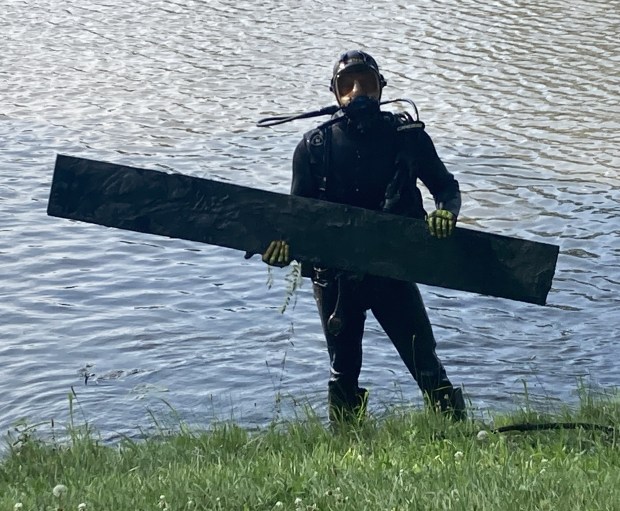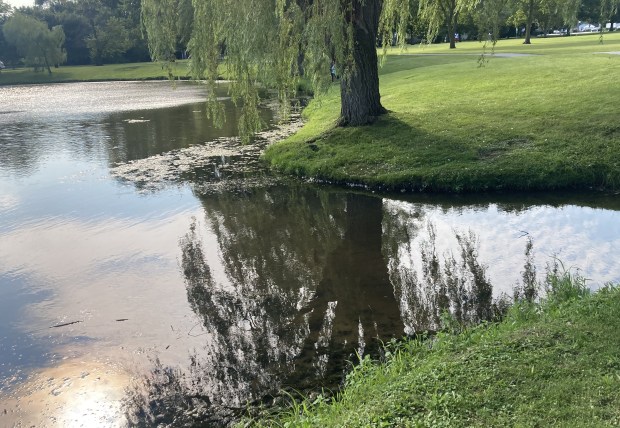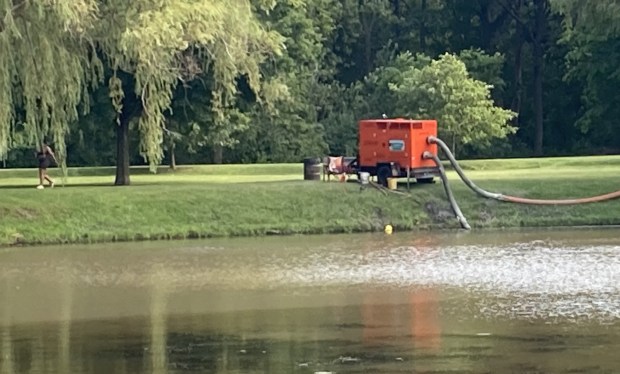When the Waukegan Park District built the pond in 1969 in what is now Bevier Park, it was 100% water with no sediment. Now, it is 39% sediment and 61% water.
By the time the sediment is removed this fall, the pond will once again be 100% water and the sediment — soil that has crept into the pond over the years — will be drying in containers to become topsoil for a pollinator prairie at nearby Henry Pfau Callahan Park.
“This is a win-win for the environment,” Tim Grimscheid, the Park District’s manager of panning survives, said on Aug. 5. “We’ll clean the pond, and have a really cool pollinator garden people can enjoy.”
Divers began removing sediment on Aug. 2 from the Bevier Park Pond and pumping it in hoses through a city storm sewer under McAree Road to Callahan Park so it can dry for use as topsoil.
“It’s not every day you can turn a landfill into something benefitting the environment,” Jonathan Taube, a park services supervisor, said. “This is a big win.”
Knowing sediment was seeping into the pond — both from a creek feeding into it and soil surrounding much of the water — Grimscheid said the Park District commissioned a study and learned the small lake has 39% less water than was originally there.
As the sediment enters the pond, he said there is less water which means not as much room for marine life to thrive. The Bevier Park Pond has areas on the shore where people can fish.
“The decomposition steals the oxygen out of the water, which means less critters can live in it,” Grimscheid said. “In a few years, those people will be catching bigger and better fish,” he added, pointing to an area where people were fishing in the park.
Removing the sediment from the pond required divers going underwater to operate the necessary equipment. Michael Kohutko, the director of operations of Organic Sediment Removal Systems, said the divers needed to see precisely what they were doing.
“They are vacuuming up the organic sediment with equipment like a large Shop-Vac,” Kohutko said. “They’re looking for anything which may have forged to the bottom. We are finding a lot of different things.”

Once pumped 1,400 feet under McAree Road to Callahan Park, Grimscheid said the sediment will be stored in large containers allowing it to dry and be reused for topsoil in the pollinator prairie.
At one time, Grimscheid said much of Illinois was prairie. Only 1/100th of 1% of the original prairie land still exists in Illinois. As it deteriorates, it impacts the ability of nature to regenerate itself, he said.
“The more we can restore of the original prairie, the more biodiversity we will have,” Grimscheid said. “It will go all the way up the food chain. Pollinators like bees, butterflies, moths, wasps and some birds will pollinate plants and crops.”
Upon completing the sediment removal, he said bricks will be placed along much of the pond’s shoreline to significantly reduce the sediment that will enter the pond in the future.

Waukegan Mayor Ann Taylor said the city is glad to cooperate with the Park District to help move the soil, avoid potential traffic conditions on McAree and aid the environment.
“These are the projects we need to have to make progress and help the environment,” she said. “The Park District plans its projects very well.”
The cost of the project will be approximately $750,000 by the time it is complete. Grimscheid said the sediment removal will cost approximately $500,000, $100,000 for the prairie and $150,000 to remediate future erosion.





